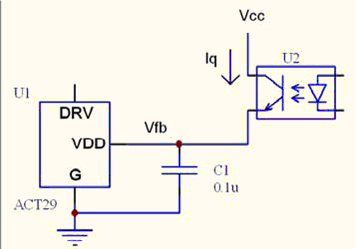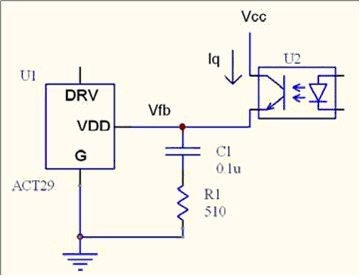请ACT30 FAE回复这个问题:
做调试时,发现图中200R的电阻对空载文波影响特别大,但是改成300R以后问题解决.请问能该吗,对整机的可靠性是否有影响?这个RC回路是什么作用?
全部回复(6)
正序查看
倒序查看
现在还没有回复呢,说说你的想法
@szlhb2008
[图片]500){this.resized=true;this.width=500;this.alt='这是一张缩略图,点击可放大。\n按住CTRL,滚动鼠标滚轮可自由缩放';this.style.cursor='hand'}"onclick="if(!this.resized){returntrue;}else{window.open('http://u.dianyuan.com/bbs/u/52/96751177818752.jpg');}"onmousewheel="returnimgzoom(this);">
关注中……………………
0
回复
提示
1. Single Capacitor Compensation 500) {this.resized=true; this.width=500; this.alt='这是一张缩略图,点击可放大。\n按住CTRL,滚动鼠标滚轮可自由缩放';this.style.cursor='hand'}" onclick="if(!this.resized) {return true;} else {window.open('http://u.dianyuan.com/bbs/u/53/95251178858944.bmp');}" onmousewheel="return imgzoom(this);">
500) {this.resized=true; this.width=500; this.alt='这是一张缩略图,点击可放大。\n按住CTRL,滚动鼠标滚轮可自由缩放';this.style.cursor='hand'}" onclick="if(!this.resized) {return true;} else {window.open('http://u.dianyuan.com/bbs/u/53/95251178858944.bmp');}" onmousewheel="return imgzoom(this);">
Vfb = Iq * (1/(S*C1)), where S = 2*π*f
Vfb/Iq = 1/(S*C1)
Vfb/Iq = (1/S) * (1/C1)
Pole at frequency = 0 Hz
Gain = (1/C1)
Therefore, small C1 will get a higher gain and faster transient response but easier to oscillate.
2. Capacitor-Resistor Compensation
 500) {this.resized=true; this.width=500; this.alt='这是一张缩略图,点击可放大。\n按住CTRL,滚动鼠标滚轮可自由缩放';this.style.cursor='hand'}" onclick="if(!this.resized) {return true;} else {window.open('http://u.dianyuan.com/bbs/u/53/95251178858989.bmp');}" onmousewheel="return imgzoom(this);">
500) {this.resized=true; this.width=500; this.alt='这是一张缩略图,点击可放大。\n按住CTRL,滚动鼠标滚轮可自由缩放';this.style.cursor='hand'}" onclick="if(!this.resized) {return true;} else {window.open('http://u.dianyuan.com/bbs/u/53/95251178858989.bmp');}" onmousewheel="return imgzoom(this);">
Vfb = Iq * (1/(S*C1) + R1), where S = 2*π*f
Vfb/Iq = 1/(S*C1) + R1
Vfb/Iq = (1+S*R1*C1) / (1/S*C1)
Vfb/Iq = (1/S) * (1/C1) * (1+S*R1*C1)
Pole at frequency = 0 Hz
Gain = (1/C1)
Zero at frequency = 1/(2*π*R1*C1)
Small C1 will get a higher gain and therefore faster transient response but easier to oscillate.
Larger R1 will also get a higher gain and phase lead and therefore faster transient response but easier to oscillate.
 500) {this.resized=true; this.width=500; this.alt='这是一张缩略图,点击可放大。\n按住CTRL,滚动鼠标滚轮可自由缩放';this.style.cursor='hand'}" onclick="if(!this.resized) {return true;} else {window.open('http://u.dianyuan.com/bbs/u/53/95251178858944.bmp');}" onmousewheel="return imgzoom(this);">
500) {this.resized=true; this.width=500; this.alt='这是一张缩略图,点击可放大。\n按住CTRL,滚动鼠标滚轮可自由缩放';this.style.cursor='hand'}" onclick="if(!this.resized) {return true;} else {window.open('http://u.dianyuan.com/bbs/u/53/95251178858944.bmp');}" onmousewheel="return imgzoom(this);">
Vfb = Iq * (1/(S*C1)), where S = 2*π*f
Vfb/Iq = 1/(S*C1)
Vfb/Iq = (1/S) * (1/C1)
Pole at frequency = 0 Hz
Gain = (1/C1)
Therefore, small C1 will get a higher gain and faster transient response but easier to oscillate.
2. Capacitor-Resistor Compensation
 500) {this.resized=true; this.width=500; this.alt='这是一张缩略图,点击可放大。\n按住CTRL,滚动鼠标滚轮可自由缩放';this.style.cursor='hand'}" onclick="if(!this.resized) {return true;} else {window.open('http://u.dianyuan.com/bbs/u/53/95251178858989.bmp');}" onmousewheel="return imgzoom(this);">
500) {this.resized=true; this.width=500; this.alt='这是一张缩略图,点击可放大。\n按住CTRL,滚动鼠标滚轮可自由缩放';this.style.cursor='hand'}" onclick="if(!this.resized) {return true;} else {window.open('http://u.dianyuan.com/bbs/u/53/95251178858989.bmp');}" onmousewheel="return imgzoom(this);">
Vfb = Iq * (1/(S*C1) + R1), where S = 2*π*f
Vfb/Iq = 1/(S*C1) + R1
Vfb/Iq = (1+S*R1*C1) / (1/S*C1)
Vfb/Iq = (1/S) * (1/C1) * (1+S*R1*C1)
Pole at frequency = 0 Hz
Gain = (1/C1)
Zero at frequency = 1/(2*π*R1*C1)
Small C1 will get a higher gain and therefore faster transient response but easier to oscillate.
Larger R1 will also get a higher gain and phase lead and therefore faster transient response but easier to oscillate.
0
回复
提示
@jerome
1.SingleCapacitorCompensation[图片]500){this.resized=true;this.width=500;this.alt='这是一张缩略图,点击可放大。\n按住CTRL,滚动鼠标滚轮可自由缩放';this.style.cursor='hand'}"onclick="if(!this.resized){returntrue;}else{window.open('http://u.dianyuan.com/bbs/u/53/95251178858944.bmp');}"onmousewheel="returnimgzoom(this);">Vfb=Iq*(1/(S*C1)),whereS=2*π*fVfb/Iq=1/(S*C1)Vfb/Iq=(1/S)*(1/C1)Poleatfrequency=0HzGain=(1/C1)Therefore,smallC1willgetahighergainandfastertransientresponsebuteasiertooscillate.2.Capacitor-ResistorCompensation[图片]500){this.resized=true;this.width=500;this.alt='这是一张缩略图,点击可放大。\n按住CTRL,滚动鼠标滚轮可自由缩放';this.style.cursor='hand'}"onclick="if(!this.resized){returntrue;}else{window.open('http://u.dianyuan.com/bbs/u/53/95251178858989.bmp');}"onmousewheel="returnimgzoom(this);">Vfb=Iq*(1/(S*C1)+R1),whereS=2*π*fVfb/Iq=1/(S*C1)+R1Vfb/Iq=(1+S*R1*C1)/(1/S*C1)Vfb/Iq=(1/S)*(1/C1)*(1+S*R1*C1)Poleatfrequency=0HzGain=(1/C1)Zeroatfrequency=1/(2*π*R1*C1)SmallC1willgetahighergainandthereforefastertransientresponsebuteasiertooscillate.LargerR1willalsogetahighergainandphaseleadandthereforefastertransientresponsebuteasiertooscillate.
高人啊,讲的太好了!
0
回复
提示
@jerome
1.SingleCapacitorCompensation[图片]500){this.resized=true;this.width=500;this.alt='这是一张缩略图,点击可放大。\n按住CTRL,滚动鼠标滚轮可自由缩放';this.style.cursor='hand'}"onclick="if(!this.resized){returntrue;}else{window.open('http://u.dianyuan.com/bbs/u/53/95251178858944.bmp');}"onmousewheel="returnimgzoom(this);">Vfb=Iq*(1/(S*C1)),whereS=2*π*fVfb/Iq=1/(S*C1)Vfb/Iq=(1/S)*(1/C1)Poleatfrequency=0HzGain=(1/C1)Therefore,smallC1willgetahighergainandfastertransientresponsebuteasiertooscillate.2.Capacitor-ResistorCompensation[图片]500){this.resized=true;this.width=500;this.alt='这是一张缩略图,点击可放大。\n按住CTRL,滚动鼠标滚轮可自由缩放';this.style.cursor='hand'}"onclick="if(!this.resized){returntrue;}else{window.open('http://u.dianyuan.com/bbs/u/53/95251178858989.bmp');}"onmousewheel="returnimgzoom(this);">Vfb=Iq*(1/(S*C1)+R1),whereS=2*π*fVfb/Iq=1/(S*C1)+R1Vfb/Iq=(1+S*R1*C1)/(1/S*C1)Vfb/Iq=(1/S)*(1/C1)*(1+S*R1*C1)Poleatfrequency=0HzGain=(1/C1)Zeroatfrequency=1/(2*π*R1*C1)SmallC1willgetahighergainandthereforefastertransientresponsebuteasiertooscillate.LargerR1willalsogetahighergainandphaseleadandthereforefastertransientresponsebuteasiertooscillate.
又学到了一点,呵呵----
0
回复
提示

 500) {this.resized=true; this.width=500; this.alt='这是一张缩略图,点击可放大。\n按住CTRL,滚动鼠标滚轮可自由缩放';this.style.cursor='hand'}" onclick="if(!this.resized) {return true;} else {window.open('http://u.dianyuan.com/bbs/u/52/96751177818752.jpg');}" onmousewheel="return imgzoom(this);">
500) {this.resized=true; this.width=500; this.alt='这是一张缩略图,点击可放大。\n按住CTRL,滚动鼠标滚轮可自由缩放';this.style.cursor='hand'}" onclick="if(!this.resized) {return true;} else {window.open('http://u.dianyuan.com/bbs/u/52/96751177818752.jpg');}" onmousewheel="return imgzoom(this);">